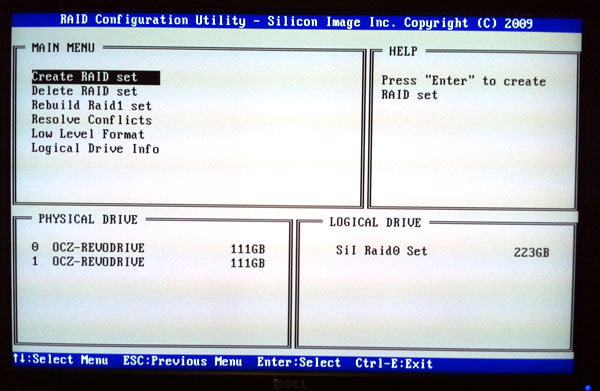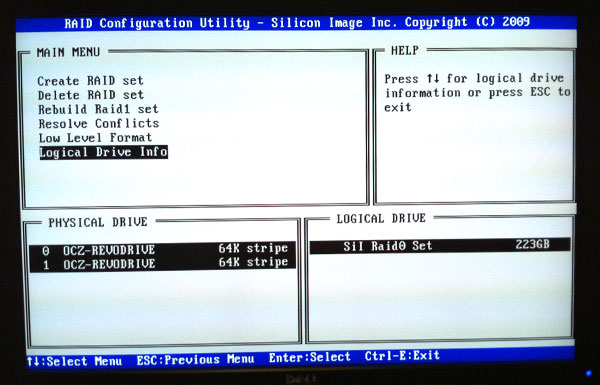OCZ's RevoDrive Preview: An Affordable PCIe SSD
by Anand Lal Shimpi on June 25, 2010 2:15 AM ESTInstallation and Early Issues
OCZ doesn’t do anything to hide what’s going on under the hood. The Silicon Image RAID BIOS loads at POST, it’ll even let you enter the BIOS and destroy the RAID array if you’d like. The first time I tried to install Windows on the RevoDrive I actually had to recreate the RAID array. I headed into the Silicon Image BIOS, asked to recreate the array, specified the entire 223GB capacity and hit ok. My sample is a bit early so I don’t expect that all users will have to deal with that, but just be aware that there are no abstraction layers here. You’re working with a pre-configured RAID array.


The RevoDrive is bootable, but you need to supply Windows with the appropriate drivers to recognize the controller. OCZ provided me with a set of 64-bit drivers for the Sil3124 controller and I was on my way. Windows 7 x64 installed without a hitch.
I did notice that I got consistency warnings between reboots however. The OS would run a chkdsk operation, find some issues with files, repair them and let me get on with things. Again, I’m not sure how much of this is due to the early nature of my sample.
The Test
| CPU | Intel Core i7 965 running at 3.2GHz (Turbo & EIST Disabled) |
| Motherboard: | Intel DX58SO (Intel X58) |
| Chipset: | Intel X58 + Marvell SATA 6Gbps PCIe |
| Chipset Drivers: | Intel 9.1.1.1015 + Intel IMSM 8.9 |
| Memory: | Qimonda DDR3-1333 4 x 1GB (7-7-7-20) |
| Video Card: | eVGA GeForce GTX 285 |
| Video Drivers: | NVIDIA ForceWare 190.38 64-bit |
| Desktop Resolution: | 1920 x 1200 |
| OS: | Windows 7 x64 |










62 Comments
View All Comments
MrBrownSound - Wednesday, August 25, 2010 - link
Should I be worried putting my OS on this drive? Also I have two steamy hot graphics cards, will a fan be needed?diqster - Sunday, September 26, 2010 - link
While you claim these PCIe SSDs are aimed at the enterprise market (they are), you didn't hit very many enterprise benchmarks or concerns. I'd like to see these things reviewed in any PCIe SSD review:1) Form factor. Can they fit in a half height or half length PCI slot? Putting this in tandem with spinning metal HD's in a 1U server would be ideal. Flashcache setups come to mind. The previous OCZ offerings failed miserably in this department as they're as long as some GPU cards.
2) You mentioned RAID controller, but no mention of a BBWC. A BBWC (like on the old OCZ R-Drive) would drastically speed up random writes. Enterprises are looking at flash to solve 2 problems, either random reads or random writes.
3) Enterprises don't care much about sequential I/O here. Very few things in a datacenter environment would use sequential I/O. For things like databases or key value stores, it's all random. Sure, video editing is sequential but it's neither enterprise (in most senses) nor is it very popular (number of DB's installed worldwide dwarfs number of video editors).
4) Addressing write lifetimes. Consumers can swap and replace these cards one at a time if they fail every 2 years. Doing that over installations of hundreds or thousands of these cards is rather hard. People want to know if they'll last. Again, a BBWC would help address some of these issues -- only letting the last write of 100 writes to a block go through.
If you want to be taken seriously, start reviewing stuff in an enterprise manner. As of now, these are consumer-based reviews of enterprise gear.